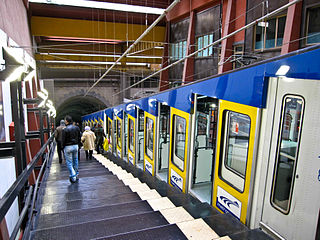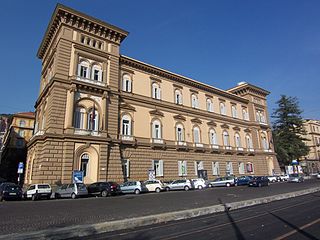Formia is a city and comune in the province of Latina, on the Mediterranean coast of Lazio, Italy. It is located halfway between Rome and Naples, and lies on the Roman-era Appian Way.

Piedigrotta is a section of the Chiaia quarter of Naples, Italy, so-called for the presence of the Church of the Madonna of Piedigrotta near the entrance to the Crypta Neapolitana. The area was also well known for an annual festival, which gave rise to a song writing competition leading to the commercial birth of the popular Neapolitan song.

Vomero is a bustling hilltop district of metropolitan Naples, Italy — comprising approximately two square kilometres (0.77 sq mi) and a population of 48,000.

Castel dell'Ovo is a seafront castle in Naples, located on the former island of Megaride, now a peninsula, on the Gulf of Naples in Italy. The castle's name comes from a legend about the Roman poet Virgil, who had a reputation in the Middle Ages as a great sorcerer and predictor of the future. In the legend, Virgil put a magical egg into the foundations to support the fortifications. It remains there along with his bones, and had this egg been broken, the castle would have been destroyed and a series of disastrous events for Naples would have followed. The castle is located between the districts of San Ferdinando and Chiaia, facing Mergellina across the sea.

The Villa Floridiana is a monumental house located amid a large park in the Vomero quarter in Naples, southern Italy. It overlooks the western Neapolitan suburbs of Chiaia and Mergellina.

The Villa Pignatelli is a museum in Naples in Southern Italy. The villa is located along the Riviera di Chiaia, the road bounding the north side of the Villa Comunale on the sea front between Mergellina and Piazza Vittoria.

Santa Caterina a Chiaia is a Roman Catholic church located on via Santa Caterina 76 in Naples, Italy. It is located near Piazza dei Martiri in the Chiaia section of the city, near where Via Santa Caterina flows toward the tree-shaded Via Chiaia.

Chiaia is an affluent neighbourhood on the seafront in Naples, Italy, bounded by Piazza Vittoria on the east and Mergellina on the west. Chiaia is one of the wealthiest districts in Naples, and many luxury brands have shops on its main street. It is also home to a business school and a medical school, as well as other public schools.
The Villa Literno–Napoli Gianturco railway is a 16 km-long double track line which connects the line to Rome via Formia with the line to Salerno near Napoli Gianturco station through Naples and its north-western suburbs. This line is used by the metropolitan trains named as line 2.

The Chiaia funicular is one of four funiculars in the public transportion system of Naples, Italy. Each system is a true funicular: an inclined railway with two passenger cars connected via cables, operating in concert.

The Mergellina Funicular, is one of four operating funiculars in the public transportion system of Naples, Italy. The system is a true funicular: an inclined railway with two passenger cars, connected via cables, operating in concert.

The Montesanto Funicular, is one of four operating funiculars in the public transportion system of Naples, Italy. The system is a true funicular: an inclined railway with two passenger cars connected via cables, operating in concert.

The historic center, or Centro Storico, of Naples, Italy represents the historic nucleus of the city, spanning 27 centuries.

Chiesa di Santa Maria in Portico is a late-baroque church in the city center of Naples placed at the end of its homonymous street, just off the seaside promenade of the Riviera di Chiaia.

The Bourbon Tunnel, Tunnel Borbonico or Bourbon Gallery is an ancient underground passage, constructed for military purposes to connect the Royal Palace to military barracks in Naples, Italy.

San Pasquale is a metro station that serves Line 6 on the Naples Metro. The San Pasquale station, designed by the architect Boris Podrecca, serves the areas of Via Caracciolo, the Villa Comunale and the central part of the Chiaia district, and part of the San Ferdinand.

The Palazzo Caravita di Sirignano is a monumental palace located at via Rione Sirignano 4, corner with along the strada Riviera di Chiaia in Naples, Italy.

The Caffè Gambrinus is a historic, private cafe or coffeehouse in Central Naples, Italy on via Chiaia. It is located in the rear of the Palazzo della Prefettura, which lies in front and to side of the Royal Palace of Naples, both of which face the Piazza del Plebiscito. The name Gambrinus is a legendary somewhat tipsy figure of joviality, and his name is used for various brands and many establishments.

The Palazzo Ravaschieri di Satriano is a monumental palace on the Riviera di Chiaia number 287, in Naples, Italy.

The Petraio is a lineal urban neighborhood and pedestrian road in Naples, Italy. It descends from what was once an expansive upper agricultural area and connects adjacent neighborhoods to downtown Naples — terminating just outside the original perimeter walls of Naples, near the present day Chiaia district.


















